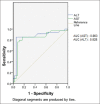Predicting and grading liver injury in the absence of computed tomographic imaging
- PMID: 37091021
- PMCID: PMC10114565
- DOI: 10.4103/jfmpc.jfmpc_1532_22
Predicting and grading liver injury in the absence of computed tomographic imaging
Abstract
Background: Even developed countries lack computed tomography (CT) scan in rural areas. Availability, affordability and accessibility of CT scan play an important role in the management of blunt hepatic trauma.
Materials and methods: A descriptive observational study among 56 hepatic blunt trauma patients as Group 1 and 56 non-hepatic blunt trauma patients as Group 2 enrolled retrospectively. Observational analysis of presence of liver trauma, grades of liver injury (I-VI) and clinical course with the liver function tests are done.
Results: Aspartate transaminase (AST) (P = 0.02) and alanine transaminase (ALT) (P = 0.003) levels were significantly elevated among Group 1. Significantly elevated levels in Group 1 than Group 2 of AST [467.5 (22-5097) vs. 95 (23-1780); P < 0.001] and of ALT [422 (28-1548) vs. 69 (20-727); P < 0.001] noted. Significant elevation of AST and ALT levels, as the AAST (American Association for the Surgery of Trauma) CT grade of liver injury increases, noted (P = 0.001). Using the ROC curve analysis, the optimal cut-off values of AST and ALT were set at ≥467.5 U/L and ≥111.5 U/L, respectively. At this cut-off, AST had sensitivity 50%, specificity 91.7%, PPV 85%, NPV 66%, ALT had sensitivity 85.3%, specificity 86.1%, PPV 85.3% and NPV 86.1% for liver injury.
Conclusion: ALT is more sensitive for liver injury. AST peak is seen in the immediate period. Combining clinical assessment, transaminase levels and Focused Assessment with Sonography in Trauma improves the sensitivity and specificity. Transaminase levels can vary with ethnicity and local epidemiological diseases; therefore, optimal cut-off levels should be established for local population. This would predict and grade the liver injury, helping in early decision-making and avoid wasting the golden hour in trauma.
Keywords: Health services research; haemorrhage; liver; tomography; transaminases; trauma; ultrasonography.
Copyright: © 2023 Journal of Family Medicine and Primary Care.
Conflict of interest statement
There are no conflicts of interest.
Figures
Similar articles
-
Defining the optimal cut-off values for liver enzymes in diagnosing blunt liver injury.BMC Res Notes. 2016 Jan 25;9:41. doi: 10.1186/s13104-016-1863-3. BMC Res Notes. 2016. PMID: 26809874 Free PMC article.
-
Role of liver enzymes in patients with blunt abdominal trauma to diagnose liver injury.Int J Emerg Med. 2021 Jan 19;14(1):7. doi: 10.1186/s12245-021-00332-1. Int J Emerg Med. 2021. PMID: 33468067 Free PMC article.
-
Is it possible to use transaminases for deciding on surgical or non-operative treatment for blunt liver trauma?Wien Klin Wochenschr. 2015 Dec;127(23-24):954-8. doi: 10.1007/s00508-015-0708-8. Epub 2015 Feb 27. Wien Klin Wochenschr. 2015. PMID: 25720571
-
Posttraumatic levels of liver enzymes can reduce the need for CT in children: a retrospective cohort study.Scand J Trauma Resusc Emerg Med. 2016 Aug 25;24(1):104. doi: 10.1186/s13049-016-0297-1. Scand J Trauma Resusc Emerg Med. 2016. PMID: 27561373 Free PMC article.
-
Pediatric Liver Injury: Physical Examination, Fast and Serum Transaminases Can Serve as a Guide.J Surg Res. 2019 Oct;242:151-156. doi: 10.1016/j.jss.2019.04.021. Epub 2019 May 9. J Surg Res. 2019. PMID: 31078899
Cited by
-
Limited Diagnostic Value of miRNAs in Early Trauma-Induced Liver Injury: Only miRNA-122 Emerges as a Late-Phase Marker.Diagnostics (Basel). 2025 Jan 14;15(2):179. doi: 10.3390/diagnostics15020179. Diagnostics (Basel). 2025. PMID: 39857063 Free PMC article.
References
-
- Karamercan A, Yilmaz TU, Karamercan MA, Aytaç B. Blunt abdominal trauma:Evaluation of diagnostic options and surgical outcomes. Ulus Travma Acil Cerrahi Derg. 2008;14:205–10. - PubMed
-
- Kumar MM, Venkataramanappa M, Venkataratnam I, Kumar NV, Babji K. Prospective evaluation of blunt abdominal trauma by computed tomography. Indian J Radiol Imaging. 2005;15:167–73.
LinkOut - more resources
Full Text Sources

